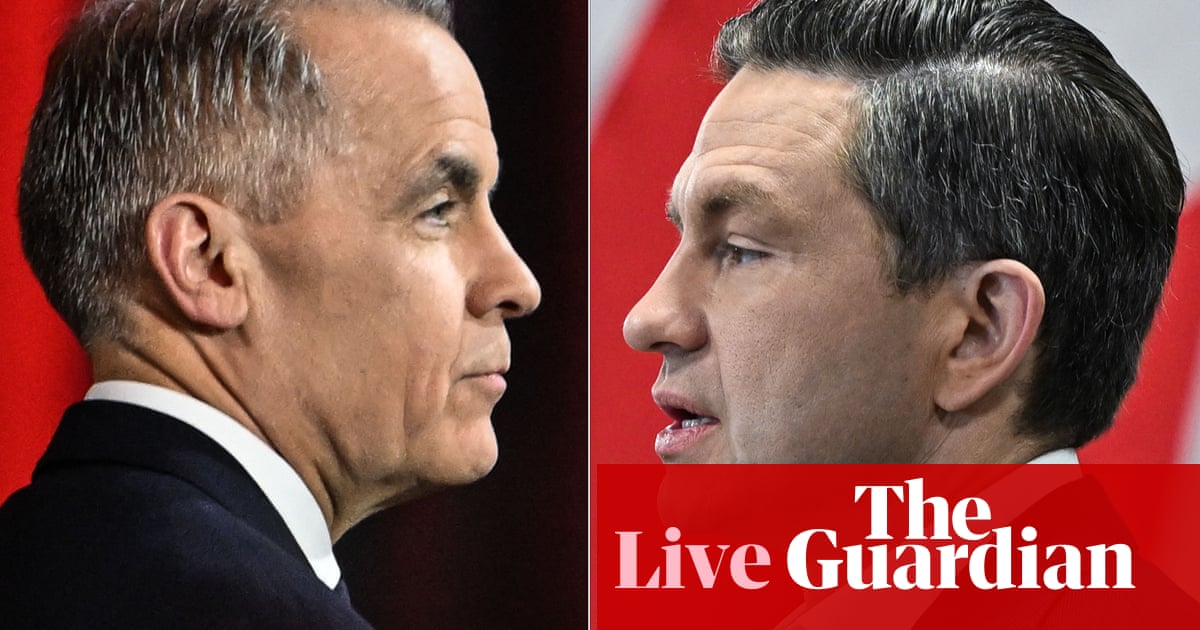In a country that spans multiple time zones, the windows of voting are set so that results can be arrived at mostly at the same time across the board. The voting windows are as follows:
Newfoundland time: 8.30am to 8.30pm
Atlantic time: 8.30am to 8.30pm
Eastern time: 9.30am to 9.30pm
Central time: 8.30am to 8.30pm
Mountain time: 7.30am to 7.30pm
Pacific time: 7am to 7pm
Until February, theConservativesenjoyed a 25 point lead over theLiberals. Pollsters gave the Tories a 99% chance of winning if an election were called at the time with one of the largest parliamentary majorities in decades. But Donald Trump’s aggressive posture towards Canada has seemingly changed all that: the Conservatives’ dominant lead has disappeared and they found themselves trailing during the twilight of the campaign.
Five parties were represented in Canada’s parliament at the point this election was called.Mark Carney’sLiberal partyheld 153 seats, shy of an overall majority.Pierre Poilievre’sConservative partyhad 120 seats, and formed the official opposition party.
Bloc Québécoishad 33 seats, theNew Democrats(NDP) 24 seats, and theGreen partyheld two seats. There were three independent seats and some vacancies.
Canadians are heading to the polls in a federal election overshadowed by fury at Donald Trump’s threats to the country’s sovereignty and fears over his escalating trade war.
In the final days of a month-long campaign – described by all party leaders as the most consequential general election in a lifetime – the US president yet again re-inserted himself into the national discussion, with fresh threats to annex the country.
Also overshadowing the final day of electioneering was adeadly attack at a bustling street festival in Vancouverthat left the country reeling and forced the prime minister, Mark Carney, to briefly suspend his campaign.
As recently as January, Canadian pollsters and political pundits struggled to find fresh ways to describe the bleak prospects for the then prime minister Justin Trudeau’s Liberal party, which seemed on track for a catastrophic blowout. The party trailed the rival Conservatives by as many as 27 points in some polls. The Conservative leader, Pierre Poilievre, was poised for the largest and most resounding electoral victory in more than half a century. That strength was the result of a laser-focused, years-long campaign to weaken the governing Liberals and the parties that supported their minority government.
But Trump’s detonation of the US’s closest diplomatic and economic relationship has fundamentally reshaped how many feel about their southern neighbour and heavily influenced how Carney, the former central banker who inherited control of the Liberal party in mid March, has shaped his electoral bid. That framing has the possibility of producing a result that would have been unfathomable three months ago.
Welcome to the Guardian’s live coverage of today’s crucial election in Canada, as polls open to determine who leads the country, with Liberal leaderMark Carneyfacing off against the Conservatives’ Pierre Poilievre to see who will emerge as prime minister …
Carney, prime minister since March, has largely run a campaign on his economic and business credentials, tacking the party towards the political centre in an attempt to lure in disaffected voters
Poilievre is seen as a brash populist and seasoned parliamentary “attack dog”, whose supporters say has given a voice to those who feel ignored and mocked by political elites
After the resignation of Justin Trudeau earlier in the year, and with the Conservative party riding high in the polls, all the signs were that the Liberals’ near-decade in power would come to an end. However, the dramatic interventions of US presidentDonald Trumpinto Canadian politics has upended the election
Canada’s federal election consists of 343 separate elections across the country held simultaneously. If either the Liberals or the Conservatives win 172 or more seats, they will have a majority government. Anything less than that and they will be required to work with other parties to pass legislation
A record 7.3 million people have already cast their ballots over four days of advanced voting. Canada has 28.9 million eligible voters
